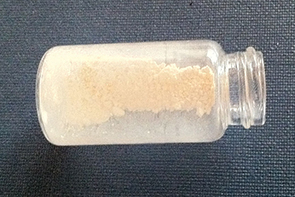 The University of Arizona has licensed a new, non-penetrating sunscreen to MexiAloe Laboratorios, S.A. de C.V., a subsidiary of Novamex.
The University of Arizona has licensed a new, non-penetrating sunscreen to MexiAloe Laboratorios, S.A. de C.V., a subsidiary of Novamex.
The novel formulation binds oxybenzone — the active ingredient in most over-the-counter sunscreens — in such a way that it does not seep into the skin. Douglas Loy, PhD, a UA professor who holds appointments in Chemistry and Biochemistry in the Colleges of Science and Medicine – Tucson, as well as a faculty position in the Department of Materials Science and Engineering in the College of Engineering, worked with graduate student Stephanie Tolbert to develop the formulation.
Blocking the absorption of oxybenzone into skin would help resolve public concern over the use of the compound, which filters out ultraviolet light and is used in many commercial topical sunscreens. The American Association of Dermatology says oxybenzone is safe, but public concerns have been raised about its effects when absorbed by users.
 Professor Douglas Loy, PhD, presents during a Tech Launch Arizona NSF I-Corps course. (Photo: Paul Tumarkin/Tech Launch Arizona)
Professor Douglas Loy, PhD, presents during a Tech Launch Arizona NSF I-Corps course. (Photo: Paul Tumarkin/Tech Launch Arizona)
Tech Launch Arizona, the office of the UA that commercializes inventions stemming from research, worked with Loy to protect the intellectual property and license the invention to MexiAloe Laboratories. MexiAloe, headquartered in Campeche, Mexico, is one of the largest suppliers of aloe vera in North America, and its parent company, Novamex, is one of the largest distributors of Mexican products in the United States.
 According to Loy, the inspiration for the invention came from Tolbert (left).
According to Loy, the inspiration for the invention came from Tolbert (left).
"Stephanie wanted to improve cosmetics by introducing sunscreens that wouldn't pass through the skin," Loy says. "In addition to being nonhazardous, we made the sunscreens last longer so they wouldn't have to be reapplied as frequently."
The underlying technology behind sunscreens has been that they take molecules that block UV light and encase them in microscopic capsules, which the industry calls "pearls." The problem is that these pearls break down and the chemicals they contain can become even more photosensitive — and then leach into the skin.
So Loy and Tolbert posed the question: Why can't we take a natural product and minimize the issue of these bothersome chemicals with naturally occurring, nontoxic alternatives and achieve the same UV protection?
 Leveraging the power of chemical bonds, the new formulation binds the pearls to the contents within, in such a way so that they do not break down.
Leveraging the power of chemical bonds, the new formulation binds the pearls to the contents within, in such a way so that they do not break down.
In addition to the science behind the invention, two additional drivers contributed to the successful licensing of the technology. First, TLA's Asset Development Program provided funds to develop the invention beyond basic research. Also, TLA's Commercialization Partners, a group of experienced entrepreneurs and business people who volunteer their advice to help bring UA inventions to market, helped provide input and strategic direction.
"We worked with MexiAloe on defining the Asset Development project, which we designed to provide the company with more of the product for them to test and validate the findings," says Paul Eynott, TLA licensing manager for the College of Science. "The CEO wrote a letter supporting the project and contributed financially to the development, as well. TLA awarded the funds to Loy's lab, and the results tipped the scales in favor of a great exclusive license arrangement."
"Personal care consumers are connecting the dots between health, environmental sustainability and natural ingredients. This trend is shaping the future of the natural personal care category," says Luis Fernandez, CEO of Novamex. "With these licensed patents from UA, we are looking forward to provide innovative solutions for consumers that now more than ever are looking for natural and functional sunscreens."
ALSO SEE:
"This Is the Absolute Best Kind of Sunscreen—Period" | Reader's Digest, Sept. 26, 2017
“New polymeric sunscreen first of its kind” | UA Daily Wildcat, Sept. 11, 2017

